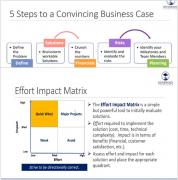Written by Kay Abikoye
 Presentation Overview
Presentation Overview
On April 28, 2021, the PMI Atlanta Governance Forum hosted speaker Peter Sherman, Managing Partner at Riverwood Associates, LLC. Mr. Sherman has led process improvement programs across the globe and specializes in quality improvement practices.
Mr. Sherman delivered a presentation centered on Benefits Realization Management and the process of crafting a convincing business case. The primary goal of a business case is to encourage buy-in within the organization and provide leadership with information to make a value-based decision. Mr. Sherman emphasized that a business case does require positive outcome, as a negative outcome could highlight opportunities for improvement or avoiding mishaps.
A convincing business case executive summary should include six elements:
- Problem - Description of what is going on and an evaluation of the Cost of Doing Nothing.
- Solution - An outline of how the solution(s) will solve the identified problem.
- Impact - Determination of quantifiable impacts and a comprehensive evaluation of which individuals in or outside of the organization will be affected.
- Financials - Metrics such as return on investment, key assumptions etc.
- Risks - Identification of regulatory, technical, financial impacts.
- Schedule and Team - A high-level project plan including key milestones, deliverables and team members.
Mr. Sherman provided five steps and considerations to developing a convincing business case. These steps include:
- Define and clarify the scope of the problem. Mr. Sherman recommends asking questions (Who, What, Where, When, and How much) when creating a problem statement and he emphasized that statements only address the symptoms not the solution.
- Solutions can take many forms and shapes and doesn’t have to be a new tool. A solution can be an improvement in an existing process. The Effort Impact Matrix is a tool that is used to evaluate various types of solutions proposed in the business case.
- Identify critical key financial metrics that provide insight into the solutions outlined in the business case. Mr. Sherman recommended metrics such as payback period, return on investment and break-even analysis.
- Risks can be identified in advance or may be referenced from previous projects. A solid business case should include risk mitigation strategies and avoidance mechanisms.
- Mr. Sherman recommended developing a schedule of key milestones when planning, and he also suggested incorporating agile methodologies for efficient delivery.
Takeaways
- A business case should be thought of as a story with an ongoing theme designed to deliver a solid project.
- Knowing your audience and their needs will elevate your business case and allow for more targeted results.
- Large projects should be broken up into smaller milestones or a phased approach.
Next Event
Join us at the next PMI Atlanta Governance Forum on May 26th, 2021.
Register at www.pmiatlanta.org/events/event-calendar

